Financial Accounting: Statement Analysis and Capital Budgeting
VerifiedAdded on 2023/06/14
|9
|967
|360
Homework Assignment
AI Summary
This assignment solution covers key areas of business accounting, including the preparation of an income statement and statement of financial position. It demonstrates the calculation of depreciation, debenture interest, and retained profits. The assignment also delves into investment appraisal techniques, calculating payback period and net present value (NPV) for a project, and discusses non-financial factors influencing investment decisions. Furthermore, it explores cost-volume-profit (CVP) analysis, calculating profit, break-even point, and margin of safety under different scenarios, while also addressing the limitations of CVP analysis. Desklib offers a wide array of study tools and solved assignments to support students in mastering these concepts.
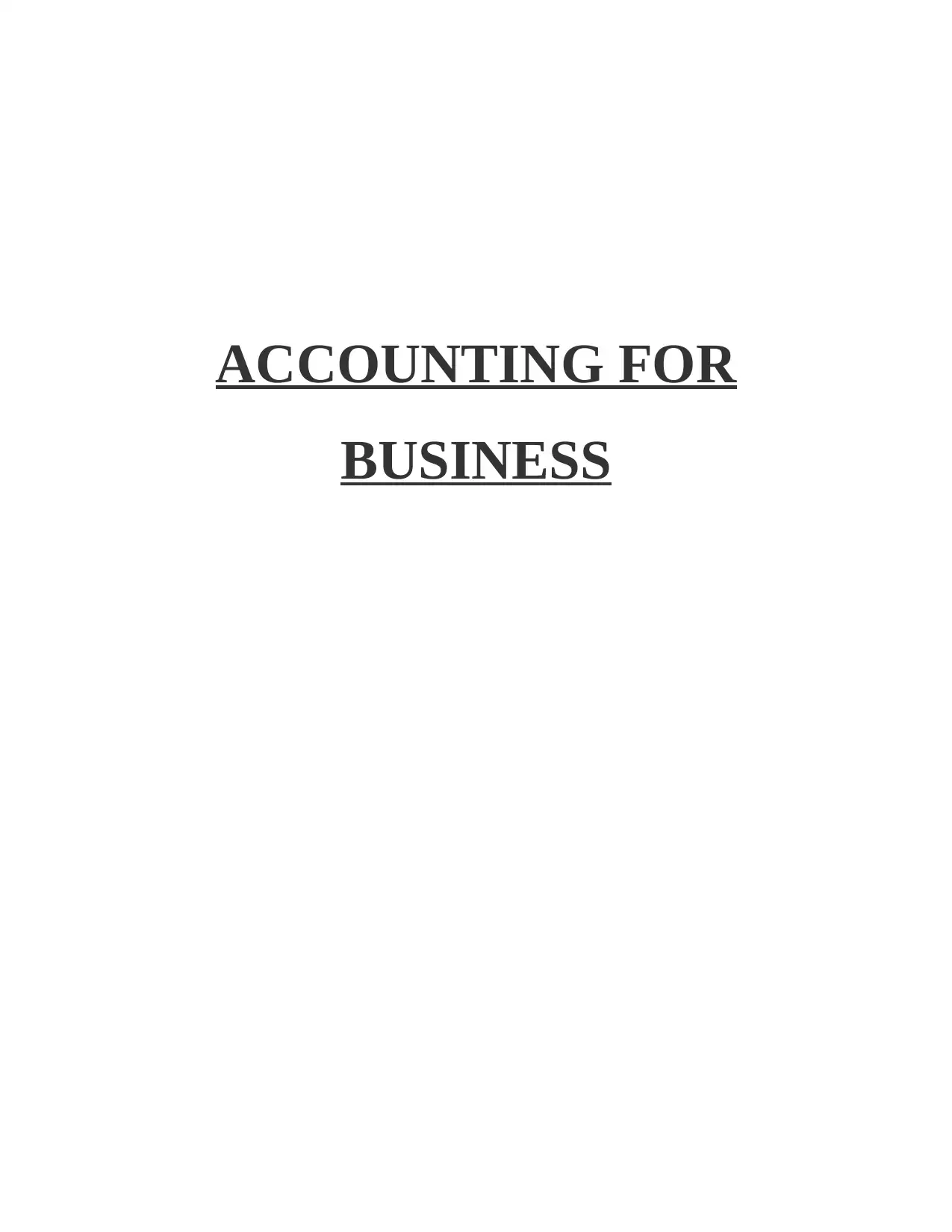
ACCOUNTING FOR
BUSINESS
BUSINESS
Paraphrase This Document
Need a fresh take? Get an instant paraphrase of this document with our AI Paraphraser
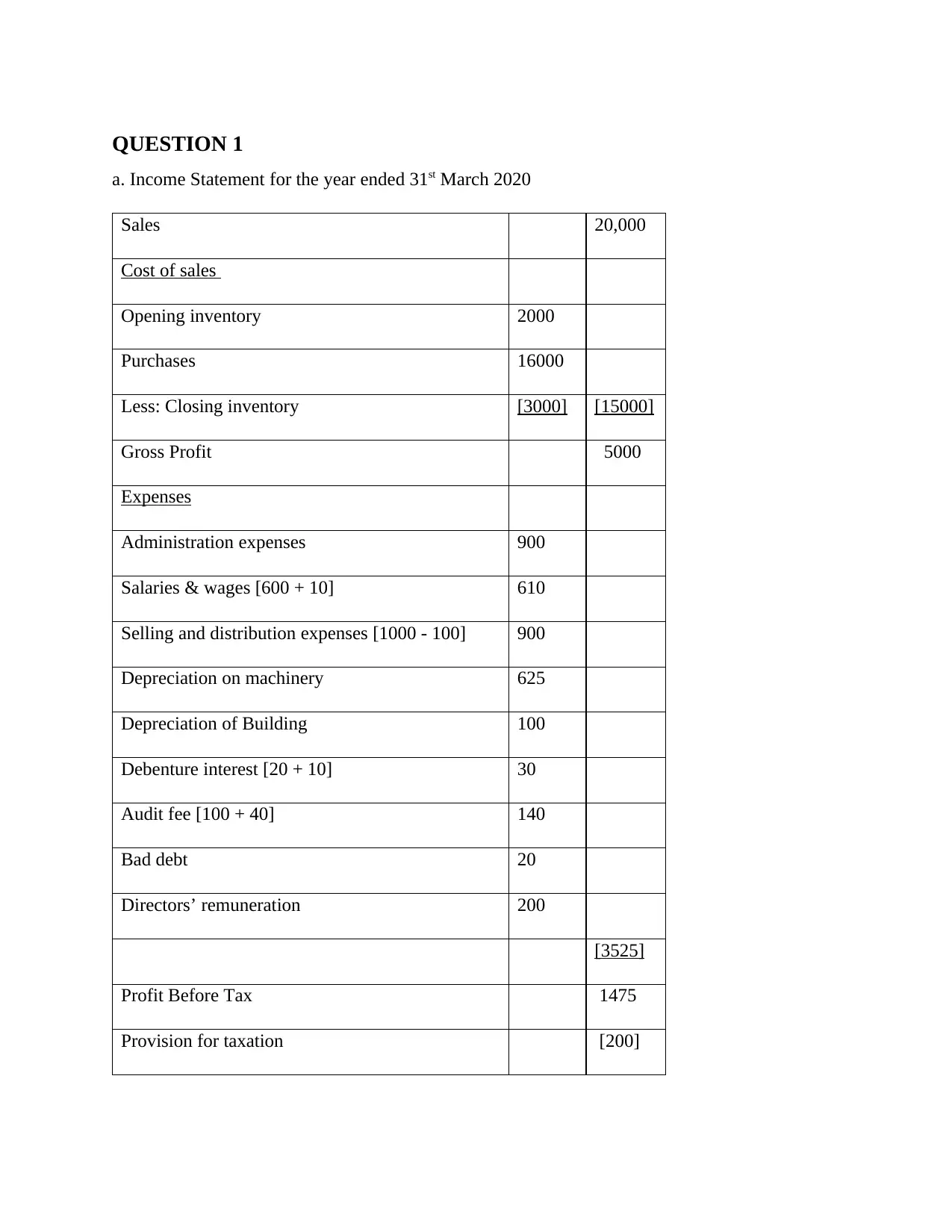
QUESTION 1
a. Income Statement for the year ended 31st March 2020
Sales 20,000
Cost of sales
Opening inventory 2000
Purchases 16000
Less: Closing inventory [3000] [15000]
Gross Profit 5000
Expenses
Administration expenses 900
Salaries & wages [600 + 10] 610
Selling and distribution expenses [1000 - 100] 900
Depreciation on machinery 625
Depreciation of Building 100
Debenture interest [20 + 10] 30
Audit fee [100 + 40] 140
Bad debt 20
Directors’ remuneration 200
[3525]
Profit Before Tax 1475
Provision for taxation [200]
a. Income Statement for the year ended 31st March 2020
Sales 20,000
Cost of sales
Opening inventory 2000
Purchases 16000
Less: Closing inventory [3000] [15000]
Gross Profit 5000
Expenses
Administration expenses 900
Salaries & wages [600 + 10] 610
Selling and distribution expenses [1000 - 100] 900
Depreciation on machinery 625
Depreciation of Building 100
Debenture interest [20 + 10] 30
Audit fee [100 + 40] 140
Bad debt 20
Directors’ remuneration 200
[3525]
Profit Before Tax 1475
Provision for taxation [200]
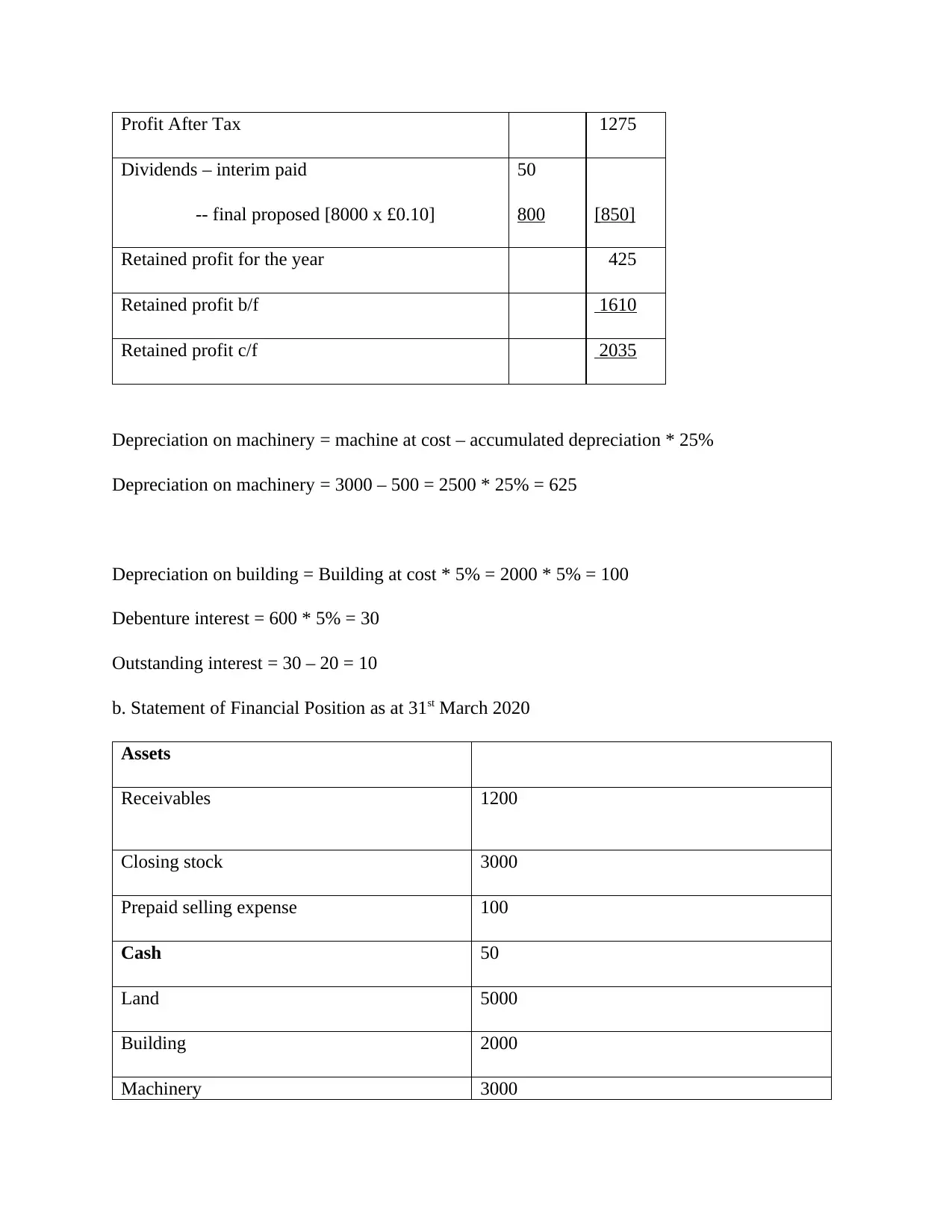
Profit After Tax 1275
Dividends – interim paid
-- final proposed [8000 x £0.10]
50
800 [850]
Retained profit for the year 425
Retained profit b/f 1610
Retained profit c/f 2035
Depreciation on machinery = machine at cost – accumulated depreciation * 25%
Depreciation on machinery = 3000 – 500 = 2500 * 25% = 625
Depreciation on building = Building at cost * 5% = 2000 * 5% = 100
Debenture interest = 600 * 5% = 30
Outstanding interest = 30 – 20 = 10
b. Statement of Financial Position as at 31st March 2020
Assets
Receivables 1200
Closing stock 3000
Prepaid selling expense 100
Cash 50
Land 5000
Building 2000
Machinery 3000
Dividends – interim paid
-- final proposed [8000 x £0.10]
50
800 [850]
Retained profit for the year 425
Retained profit b/f 1610
Retained profit c/f 2035
Depreciation on machinery = machine at cost – accumulated depreciation * 25%
Depreciation on machinery = 3000 – 500 = 2500 * 25% = 625
Depreciation on building = Building at cost * 5% = 2000 * 5% = 100
Debenture interest = 600 * 5% = 30
Outstanding interest = 30 – 20 = 10
b. Statement of Financial Position as at 31st March 2020
Assets
Receivables 1200
Closing stock 3000
Prepaid selling expense 100
Cash 50
Land 5000
Building 2000
Machinery 3000
⊘ This is a preview!⊘
Do you want full access?
Subscribe today to unlock all pages.

Trusted by 1+ million students worldwide
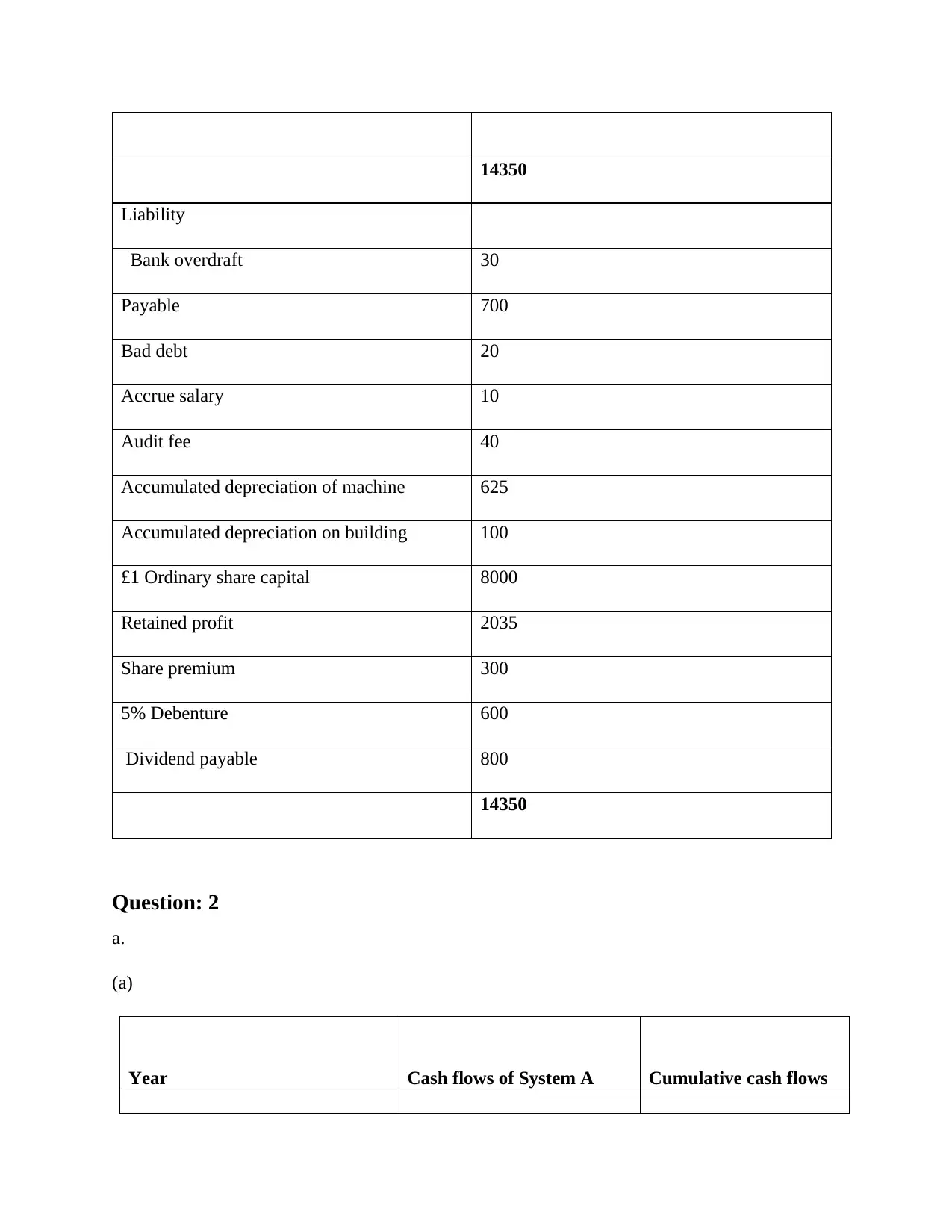
14350
Liability
Bank overdraft 30
Payable 700
Bad debt 20
Accrue salary 10
Audit fee 40
Accumulated depreciation of machine 625
Accumulated depreciation on building 100
£1 Ordinary share capital 8000
Retained profit 2035
Share premium 300
5% Debenture 600
Dividend payable 800
14350
Question: 2
a.
(a)
Year Cash flows of System A Cumulative cash flows
Liability
Bank overdraft 30
Payable 700
Bad debt 20
Accrue salary 10
Audit fee 40
Accumulated depreciation of machine 625
Accumulated depreciation on building 100
£1 Ordinary share capital 8000
Retained profit 2035
Share premium 300
5% Debenture 600
Dividend payable 800
14350
Question: 2
a.
(a)
Year Cash flows of System A Cumulative cash flows
Paraphrase This Document
Need a fresh take? Get an instant paraphrase of this document with our AI Paraphraser
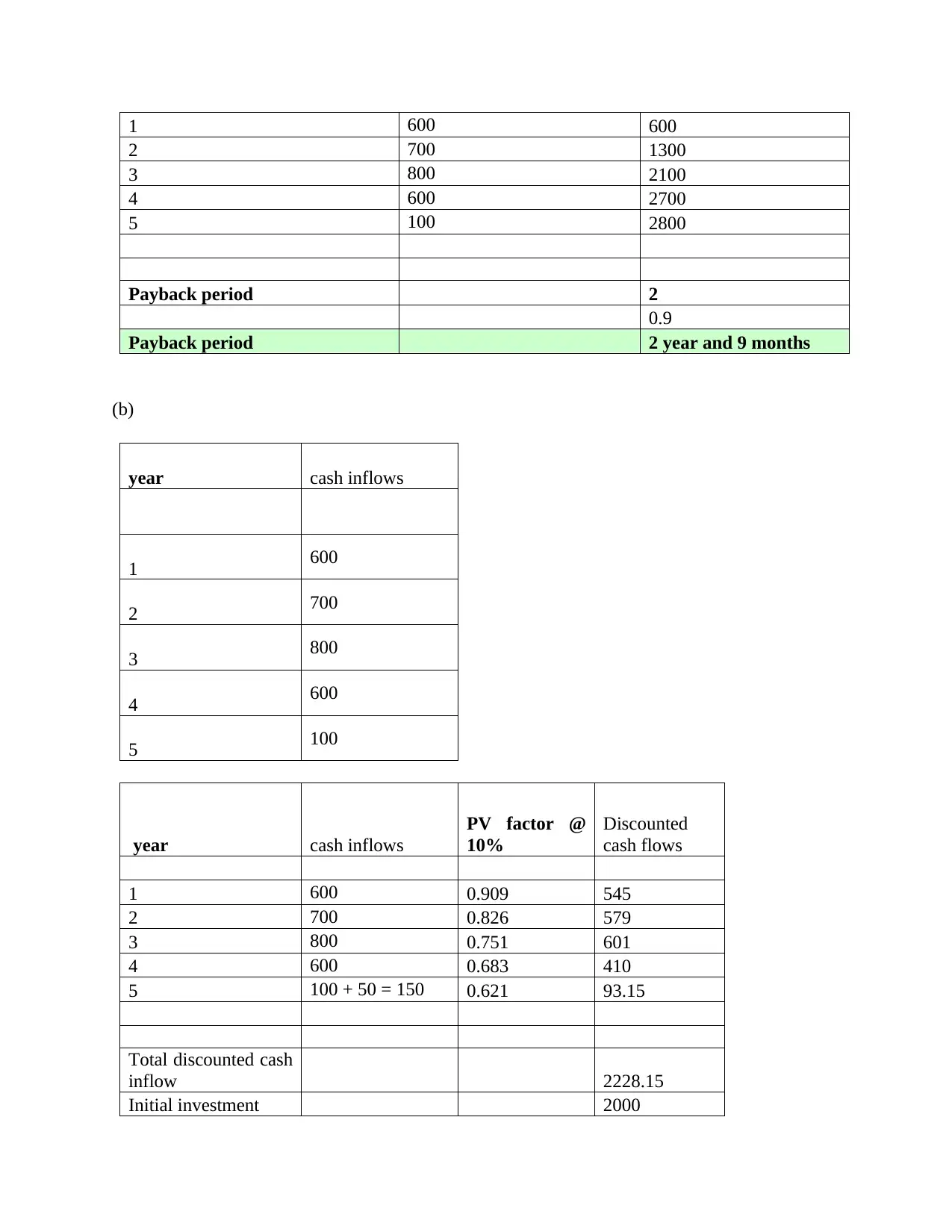
1 600 600
2 700 1300
3 800 2100
4 600 2700
5 100 2800
Payback period 2
0.9
Payback period 2 year and 9 months
(b)
year cash inflows
1 600
2 700
3 800
4 600
5 100
year cash inflows
PV factor @
10%
Discounted
cash flows
1 600 0.909 545
2 700 0.826 579
3 800 0.751 601
4 600 0.683 410
5 100 + 50 = 150 0.621 93.15
Total discounted cash
inflow 2228.15
Initial investment 2000
2 700 1300
3 800 2100
4 600 2700
5 100 2800
Payback period 2
0.9
Payback period 2 year and 9 months
(b)
year cash inflows
1 600
2 700
3 800
4 600
5 100
year cash inflows
PV factor @
10%
Discounted
cash flows
1 600 0.909 545
2 700 0.826 579
3 800 0.751 601
4 600 0.683 410
5 100 + 50 = 150 0.621 93.15
Total discounted cash
inflow 2228.15
Initial investment 2000
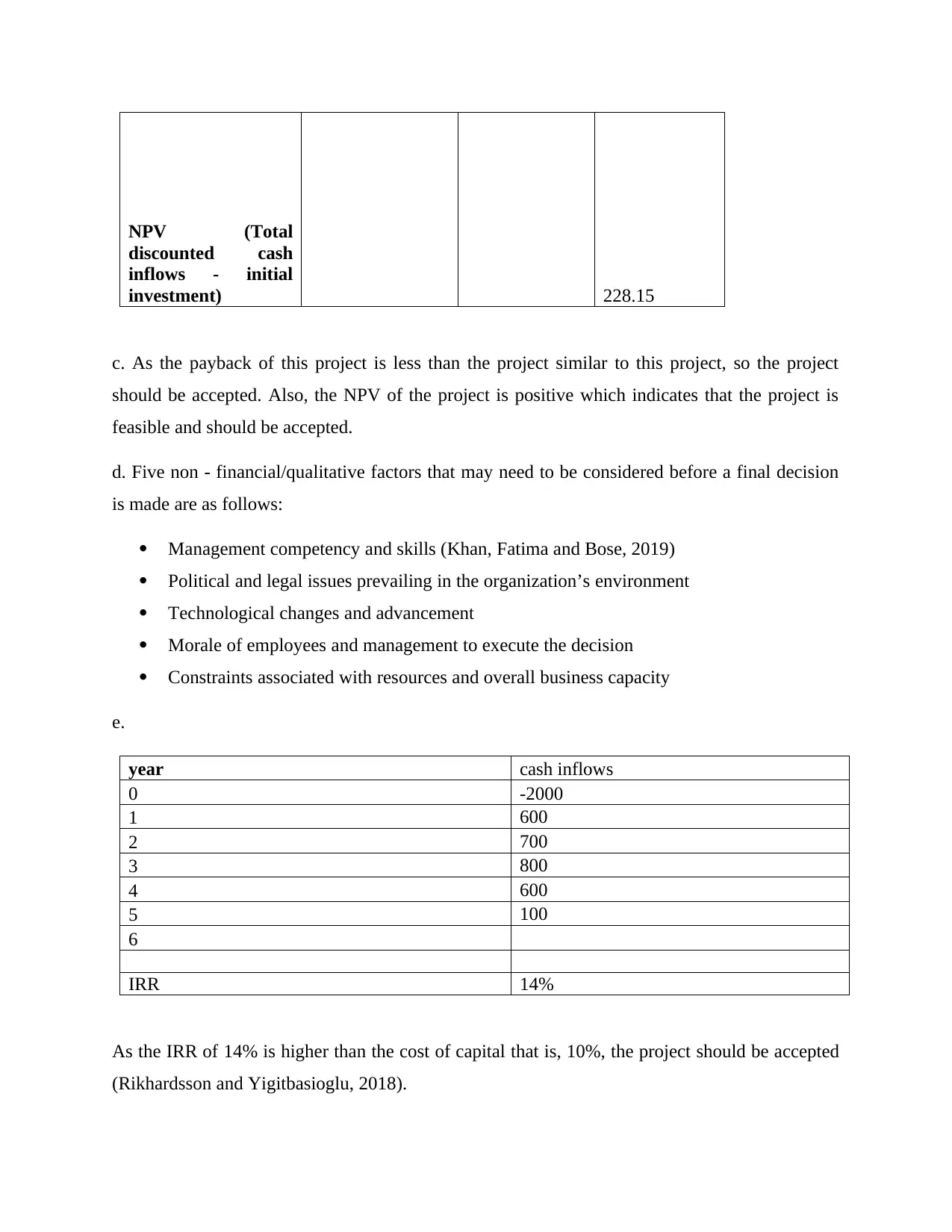
NPV (Total
discounted cash
inflows - initial
investment) 228.15
c. As the payback of this project is less than the project similar to this project, so the project
should be accepted. Also, the NPV of the project is positive which indicates that the project is
feasible and should be accepted.
d. Five non - financial/qualitative factors that may need to be considered before a final decision
is made are as follows:
Management competency and skills (Khan, Fatima and Bose, 2019)
Political and legal issues prevailing in the organization’s environment
Technological changes and advancement
Morale of employees and management to execute the decision
Constraints associated with resources and overall business capacity
e.
year cash inflows
0 -2000
1 600
2 700
3 800
4 600
5 100
6
IRR 14%
As the IRR of 14% is higher than the cost of capital that is, 10%, the project should be accepted
(Rikhardsson and Yigitbasioglu, 2018).
discounted cash
inflows - initial
investment) 228.15
c. As the payback of this project is less than the project similar to this project, so the project
should be accepted. Also, the NPV of the project is positive which indicates that the project is
feasible and should be accepted.
d. Five non - financial/qualitative factors that may need to be considered before a final decision
is made are as follows:
Management competency and skills (Khan, Fatima and Bose, 2019)
Political and legal issues prevailing in the organization’s environment
Technological changes and advancement
Morale of employees and management to execute the decision
Constraints associated with resources and overall business capacity
e.
year cash inflows
0 -2000
1 600
2 700
3 800
4 600
5 100
6
IRR 14%
As the IRR of 14% is higher than the cost of capital that is, 10%, the project should be accepted
(Rikhardsson and Yigitbasioglu, 2018).
⊘ This is a preview!⊘
Do you want full access?
Subscribe today to unlock all pages.

Trusted by 1+ million students worldwide
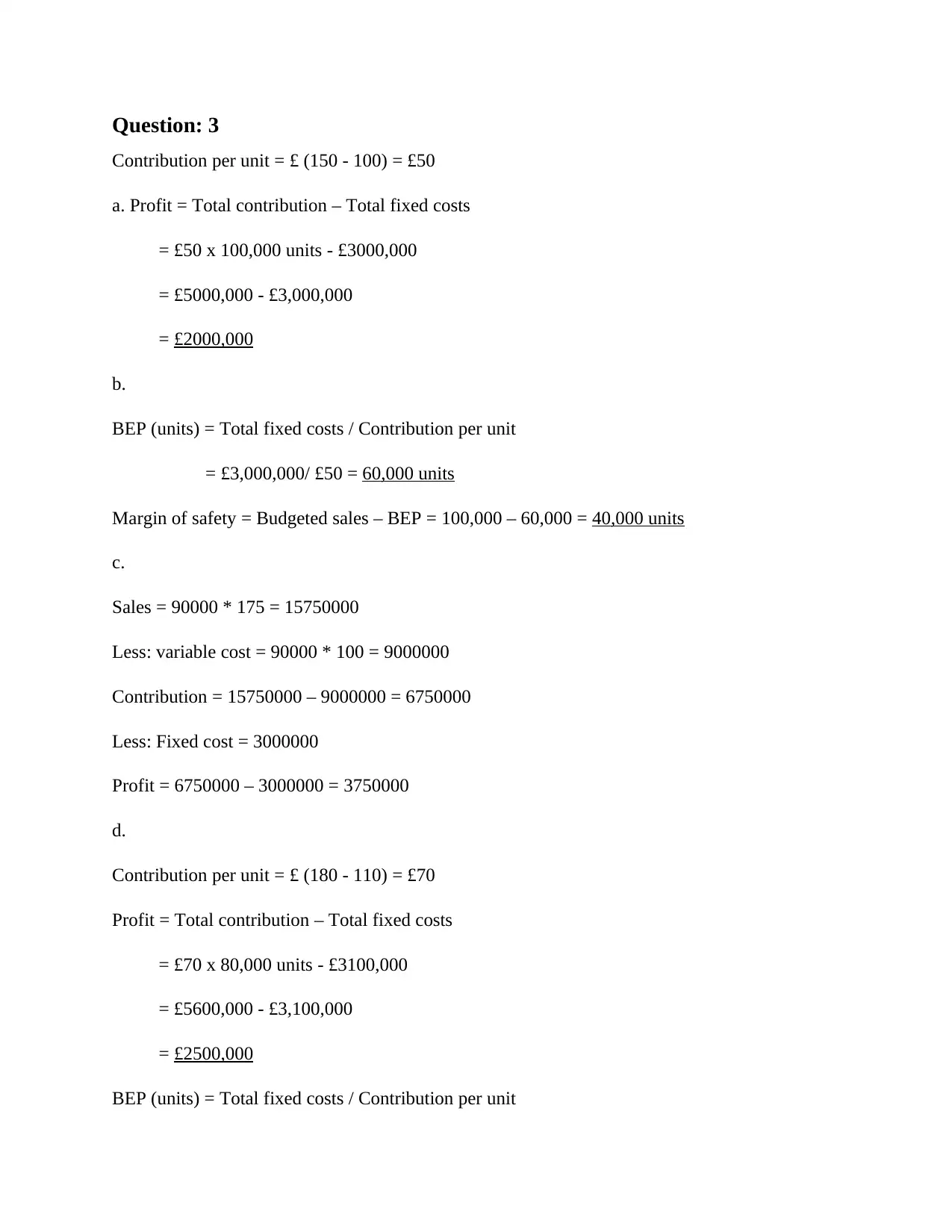
Question: 3
Contribution per unit = £ (150 - 100) = £50
a. Profit = Total contribution – Total fixed costs
= £50 x 100,000 units - £3000,000
= £5000,000 - £3,000,000
= £2000,000
b.
BEP (units) = Total fixed costs / Contribution per unit
= £3,000,000/ £50 = 60,000 units
Margin of safety = Budgeted sales – BEP = 100,000 – 60,000 = 40,000 units
c.
Sales = 90000 * 175 = 15750000
Less: variable cost = 90000 * 100 = 9000000
Contribution = 15750000 – 9000000 = 6750000
Less: Fixed cost = 3000000
Profit = 6750000 – 3000000 = 3750000
d.
Contribution per unit = £ (180 - 110) = £70
Profit = Total contribution – Total fixed costs
= £70 x 80,000 units - £3100,000
= £5600,000 - £3,100,000
= £2500,000
BEP (units) = Total fixed costs / Contribution per unit
Contribution per unit = £ (150 - 100) = £50
a. Profit = Total contribution – Total fixed costs
= £50 x 100,000 units - £3000,000
= £5000,000 - £3,000,000
= £2000,000
b.
BEP (units) = Total fixed costs / Contribution per unit
= £3,000,000/ £50 = 60,000 units
Margin of safety = Budgeted sales – BEP = 100,000 – 60,000 = 40,000 units
c.
Sales = 90000 * 175 = 15750000
Less: variable cost = 90000 * 100 = 9000000
Contribution = 15750000 – 9000000 = 6750000
Less: Fixed cost = 3000000
Profit = 6750000 – 3000000 = 3750000
d.
Contribution per unit = £ (180 - 110) = £70
Profit = Total contribution – Total fixed costs
= £70 x 80,000 units - £3100,000
= £5600,000 - £3,100,000
= £2500,000
BEP (units) = Total fixed costs / Contribution per unit
Paraphrase This Document
Need a fresh take? Get an instant paraphrase of this document with our AI Paraphraser
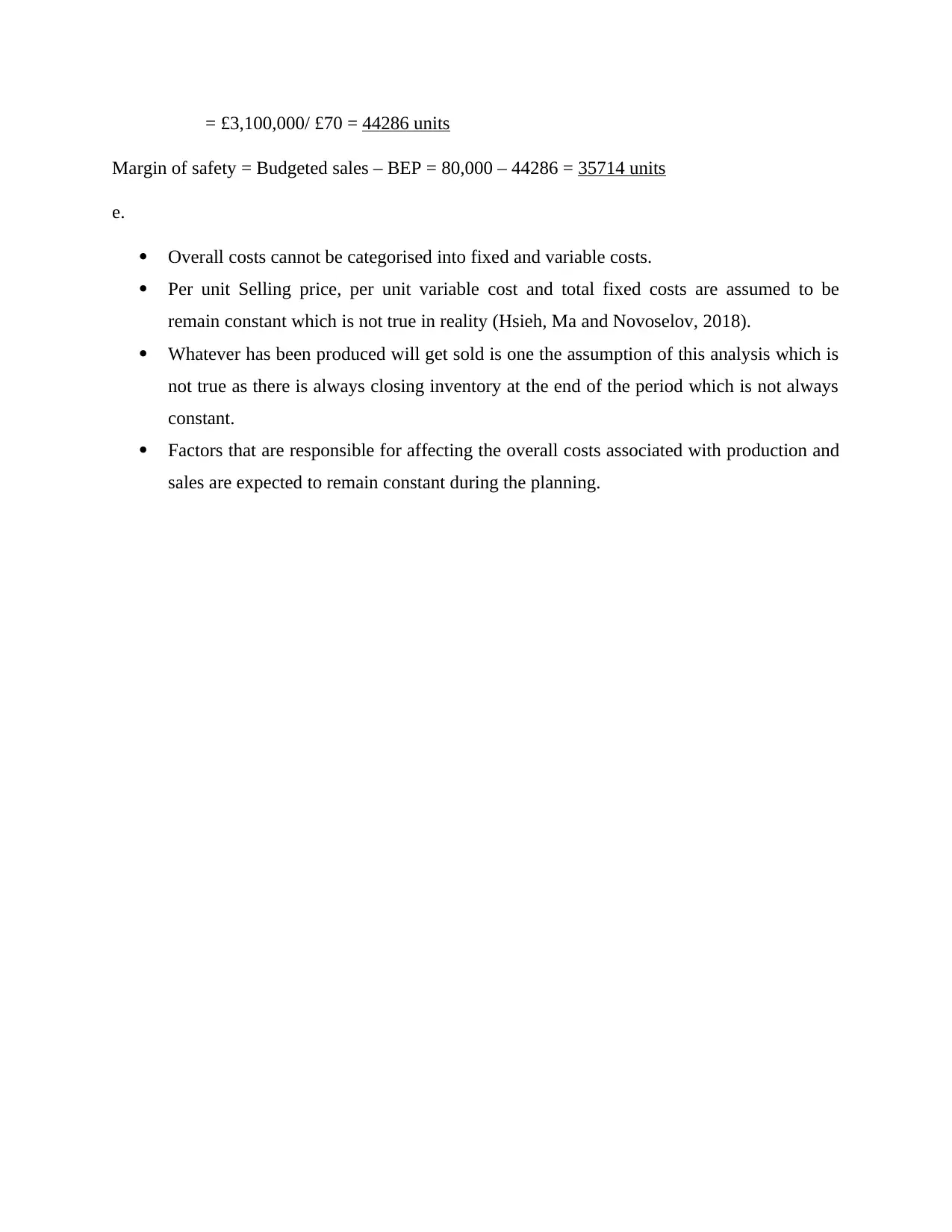
= £3,100,000/ £70 = 44286 units
Margin of safety = Budgeted sales – BEP = 80,000 – 44286 = 35714 units
e.
Overall costs cannot be categorised into fixed and variable costs.
Per unit Selling price, per unit variable cost and total fixed costs are assumed to be
remain constant which is not true in reality (Hsieh, Ma and Novoselov, 2018).
Whatever has been produced will get sold is one the assumption of this analysis which is
not true as there is always closing inventory at the end of the period which is not always
constant.
Factors that are responsible for affecting the overall costs associated with production and
sales are expected to remain constant during the planning.
Margin of safety = Budgeted sales – BEP = 80,000 – 44286 = 35714 units
e.
Overall costs cannot be categorised into fixed and variable costs.
Per unit Selling price, per unit variable cost and total fixed costs are assumed to be
remain constant which is not true in reality (Hsieh, Ma and Novoselov, 2018).
Whatever has been produced will get sold is one the assumption of this analysis which is
not true as there is always closing inventory at the end of the period which is not always
constant.
Factors that are responsible for affecting the overall costs associated with production and
sales are expected to remain constant during the planning.
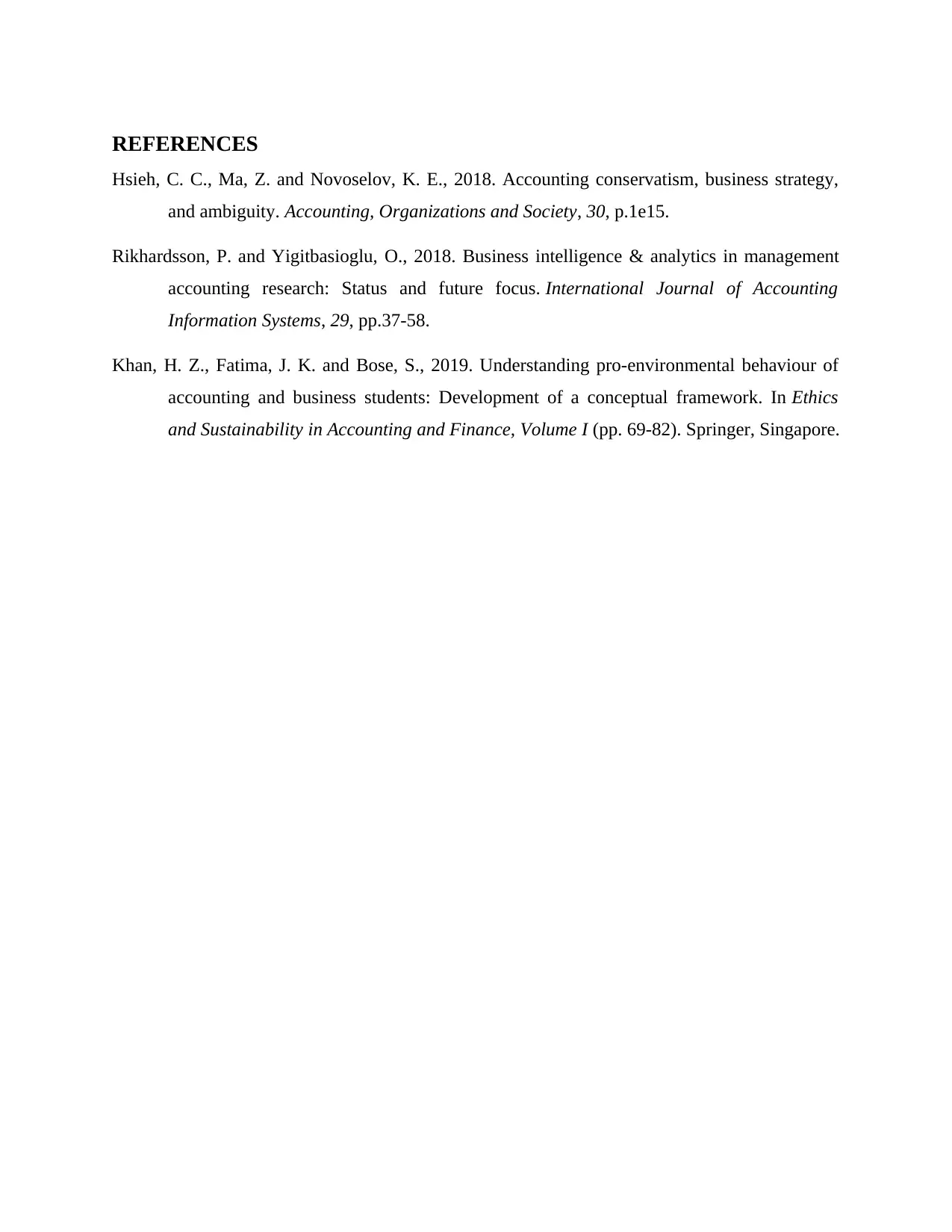
REFERENCES
Hsieh, C. C., Ma, Z. and Novoselov, K. E., 2018. Accounting conservatism, business strategy,
and ambiguity. Accounting, Organizations and Society, 30, p.1e15.
Rikhardsson, P. and Yigitbasioglu, O., 2018. Business intelligence & analytics in management
accounting research: Status and future focus. International Journal of Accounting
Information Systems, 29, pp.37-58.
Khan, H. Z., Fatima, J. K. and Bose, S., 2019. Understanding pro-environmental behaviour of
accounting and business students: Development of a conceptual framework. In Ethics
and Sustainability in Accounting and Finance, Volume I (pp. 69-82). Springer, Singapore.
Hsieh, C. C., Ma, Z. and Novoselov, K. E., 2018. Accounting conservatism, business strategy,
and ambiguity. Accounting, Organizations and Society, 30, p.1e15.
Rikhardsson, P. and Yigitbasioglu, O., 2018. Business intelligence & analytics in management
accounting research: Status and future focus. International Journal of Accounting
Information Systems, 29, pp.37-58.
Khan, H. Z., Fatima, J. K. and Bose, S., 2019. Understanding pro-environmental behaviour of
accounting and business students: Development of a conceptual framework. In Ethics
and Sustainability in Accounting and Finance, Volume I (pp. 69-82). Springer, Singapore.
⊘ This is a preview!⊘
Do you want full access?
Subscribe today to unlock all pages.

Trusted by 1+ million students worldwide
1 out of 9
Related Documents
Your All-in-One AI-Powered Toolkit for Academic Success.
+13062052269
info@desklib.com
Available 24*7 on WhatsApp / Email
![[object Object]](/_next/static/media/star-bottom.7253800d.svg)
Unlock your academic potential
Copyright © 2020–2025 A2Z Services. All Rights Reserved. Developed and managed by ZUCOL.


